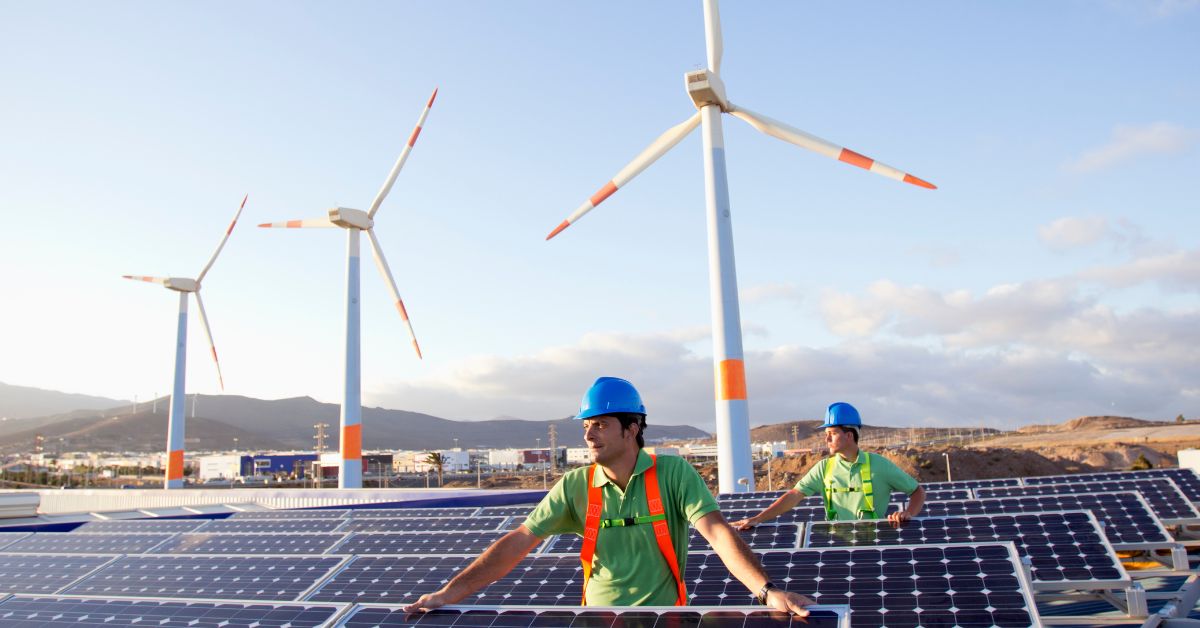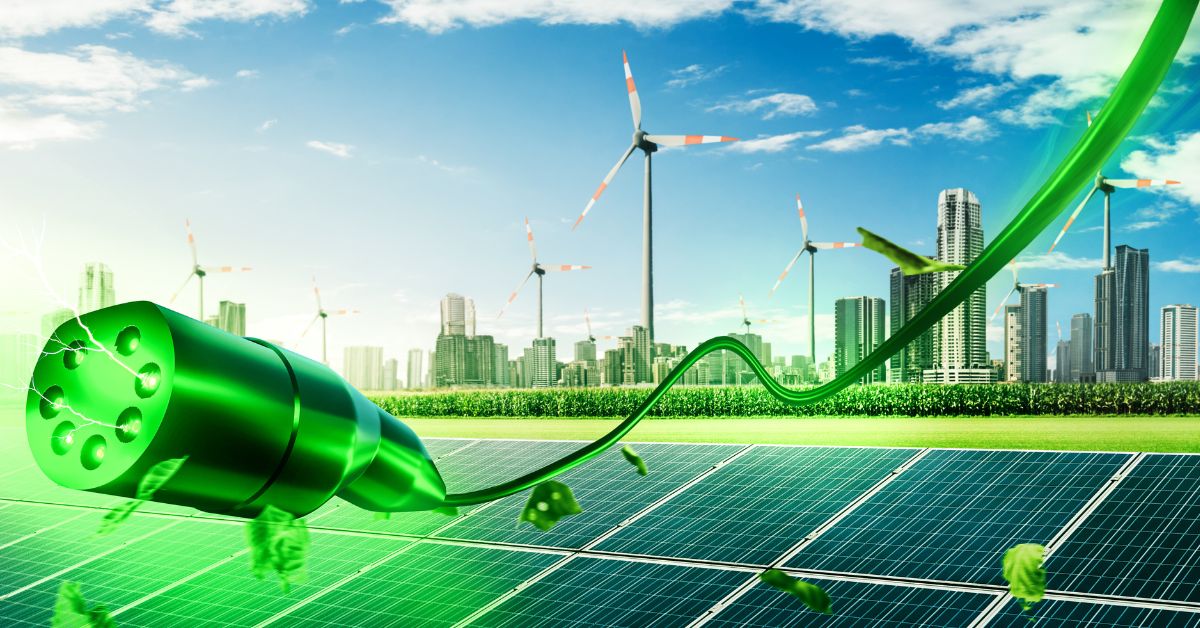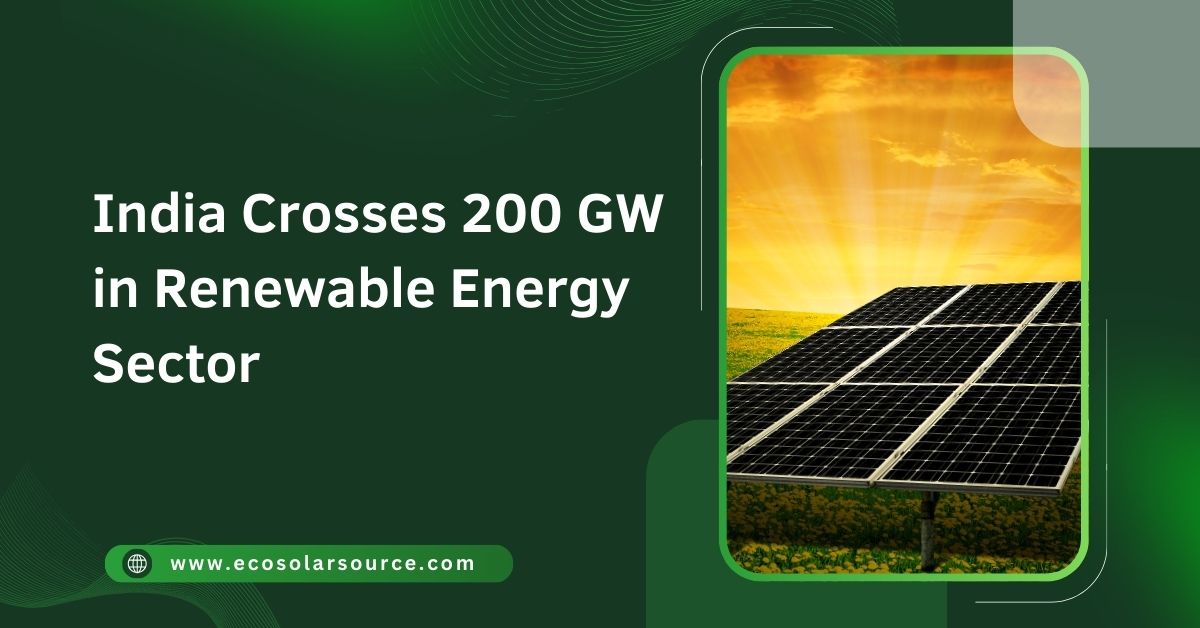India Crosses 200 GW in Renewable Energy Sector
Know the details about India Crosses 200 GW in Renewable Energy Sector, India has achieved a remarkable milestone by crossing 200 GW of renewable energy capacity, a significant leap toward its sustainable energy goals. This achievement reflects the country’s growing focus on clean energy sources like solar, wind, hydropower, and bioenergy.
With ambitious plans to reach 500 GW by 2030, India’s renewable energy sector rapidly transforms the global energy landscape. This shift reduces the nation’s reliance on fossil fuels and contributes to combating climate change. By fostering innovation, investment, and international collaboration, India is positioning itself as a global green energy revolution leader.
Table of Contents
India Crosses 200 GW in Renewable Energy Sector: A Landmark Achievement
In a remarkable stride towards sustainable development, India has recently crossed the 200 GW (Gigawatts) milestone in its renewable energy sector. This achievement marks a significant step in the country’s transition from fossil fuels to cleaner, greener, and more sustainable energy sources. India has been aggressively expanding its renewable energy capacity, and this milestone not only underlines its global leadership in renewable energy but also highlights the country’s commitment to combating climate change and ensuring energy security for its population of over 1.4 billion people.
This achievement is a significant part of India’s broader goal to reach 500 GW of non-fossil fuel energy capacity by 2030, as outlined in the Paris Agreement and reiterated at the COP26 summit in Glasgow. The journey towards achieving the 200 GW mark has been driven by various policy initiatives, technological advancements, and public-private partnerships that have turned India into a global player in the renewable energy sector. In this comprehensive blog post, we will explore the various dimensions of this achievement, including its historical context, the major contributors to the milestone, the challenges faced, and the way forward for India’s renewable energy landscape.
The Growth Trajectory of Renewable Energy in India
India’s journey toward 200 GW of renewable energy capacity began in earnest in the early 2000s. While the country had long been aware of its vast renewable energy potential, it was only in the last two decades that concerted efforts were made to harness this potential. The renewable energy sector in India has experienced exponential growth, driven by technological advances, falling costs of renewable energy technologies, and strong government support.

- Historical Overview
India’s renewable energy sector began with small-scale projects in hydropower and biomass in the 1980s. However, these early initiatives were limited in scale and scope, primarily due to technological and financial constraints. The real breakthrough came with the National Action Plan on Climate Change (NAPCC) in 2008, which created the National Solar Mission to promote the development of solar energy. This mission, launched in 2010, set ambitious targets for solar capacity and laid the foundation for India’s renewable energy revolution. Around the same time, the government also began incentivizing wind energy projects, which soon became one of the major contributors to India’s renewable energy capacity. As of 2023, wind and solar power account for the bulk of India’s renewable energy capacity. - Government Initiatives and Policy Frameworks
A significant part of India’s success in renewable energy can be attributed to proactive government policies. In recent years, the government has launched several initiatives aimed at boosting renewable energy, such as the National Solar Mission, National Wind Energy Mission, and the Green Energy Corridor Project. Key policy measures include:- Subsidies and Incentives: The Indian government has provided various financial incentives, including tax breaks and subsidies, to renewable energy developers. This has lowered the financial risks associated with setting up renewable energy projects.
- Renewable Purchase Obligations (RPOs): State electricity distribution companies (DISCOMs) are mandated to procure a certain percentage of their power from renewable sources. This has increased the demand for clean energy.
- Auction-Based Tariff Models: The introduction of competitive bidding for renewable energy projects has driven down costs. Solar power tariffs, for instance, have fallen significantly over the last decade, making renewable energy more competitive with conventional sources.
- International Collaborations: India has also entered into partnerships with global institutions and other countries to advance its renewable energy goals. Notably, the International Solar Alliance (ISA), launched by India and France, aims to promote solar energy use in developing countries.
Major Contributors to the 200 GW Milestone
The 200 GW mark is the result of contributions from a diverse mix of renewable energy sources, including solar, wind, hydropower, and biomass. Each of these sectors has played a crucial role in the achievement, although solar and wind energy have emerged as the dominant players.

- Solar Energy
India’s solar energy capacity has grown rapidly, making it one of the leading solar markets globally. In 2023, solar power accounted for more than 60 GW of India’s renewable energy capacity. The massive growth in solar energy can be attributed to several factors, including falling costs of solar panels, government subsidies, and the launch of mega solar parks.- Solar Parks and Rooftop Solar: India has developed several large-scale solar parks, such as the Pavagada Solar Park in Karnataka and the Bhadla Solar Park in Rajasthan, which are among the largest in the world. These parks have attracted both domestic and international investors, further boosting capacity. Rooftop solar installations have also been promoted extensively in urban areas.
- Technological Innovations: Technological advancements in solar energy, such as bifacial panels and solar tracking systems, have increased efficiency and made solar power more viable. Additionally, India is investing in solar storage solutions to address intermittency issues.
- Wind Energy
Wind energy has been one of the pioneers in India’s renewable energy sector. India currently has a wind energy capacity of over 45 GW, making it one of the largest wind energy producers in the world. The country’s vast coastline and favorable wind conditions in states like Tamil Nadu, Gujarat, and Maharashtra have contributed significantly to this growth.- Onshore and Offshore Wind Projects: While onshore wind has traditionally been the dominant segment, India is now exploring offshore wind energy potential, particularly along the coasts of Gujarat and Tamil Nadu. The government has already issued tenders for offshore wind projects, which could significantly boost the sector’s capacity.
- Repowering Old Wind Farms: Many of India’s older wind farms are being repowered with new, more efficient turbines to increase energy output from existing sites. This repowering effort has the potential to add several gigawatts of additional capacity.
- Hydropower
Hydropower has been a reliable source of renewable energy for India, with a capacity of around 46 GW. While new large-scale hydropower projects have slowed down due to environmental concerns and displacement issues, small and mini hydropower projects are still being developed in remote areas.- Run-of-the-River Projects: These projects, which do not require large dams, have emerged as a more environmentally friendly alternative to traditional hydropower projects. They have minimal impact on local ecosystems and communities while still contributing to India’s renewable energy capacity.
- Pumped Storage: India is also exploring pumped storage hydropower plants as a means of storing surplus renewable energy, particularly solar and wind, and releasing it during periods of high demand.
- Biomass and Waste-to-Energy
Biomass and waste-to-energy projects have played a smaller but still significant role in India’s renewable energy mix, contributing around 10 GW of capacity. These projects are particularly important in rural areas, where agricultural waste and organic materials can be used to generate electricity. Additionally, urban waste-to-energy plants are helping to reduce landfill waste and produce clean energy simultaneously.
Challenges in Achieving the 200 GW Milestone
While India’s achievement of 200 GW in renewable energy is commendable, it has not been without its challenges. Some of the key challenges faced by the sector include:
- Grid Integration and Stability
As renewable energy sources like solar and wind are intermittent by nature, integrating them into the national grid has proven to be a complex task. The Indian grid needs to be upgraded and modernized to handle the variability of renewable energy. Issues such as frequency fluctuations and voltage control must be addressed to ensure a stable power supply. The Green Energy Corridor project, which aims to create dedicated transmission infrastructure for renewable energy, is a step in the right direction, but further investments are needed to enhance grid capacity and ensure seamless integration. - Land Acquisition and Environmental Clearances
Land acquisition remains a major hurdle for large-scale renewable energy projects, particularly solar and wind farms. In densely populated areas, finding suitable land for projects without displacing local communities or affecting agricultural activities can be difficult. Additionally, environmental clearances for projects located near ecologically sensitive areas can cause delays and increase costs. - Financing and Investment
While renewable energy costs have fallen dramatically, financing large-scale projects remains a challenge, especially in a country like India where interest rates can be high. Securing long-term financing at competitive rates is crucial to the success of renewable energy projects. Moreover, the financial health of state DISCOMs is a major concern, as they are often unable to pay renewable energy developers on time, leading to cash flow issues. - Skilled Workforce and Technology Transfer
The renewable energy sector is highly specialized and requires a skilled workforce to design, install, and maintain the technologies involved. India faces a shortage of skilled professionals in this field, particularly in areas such as solar panel manufacturing and wind turbine maintenance. In addition, India relies heavily on imported technology, particularly for solar panels and wind turbines, which makes the sector vulnerable to supply chain disruptions and price fluctuations.
The Road Ahead: Future Prospects for India’s Renewable Energy Sector
Crossing the 200 GW mark is a significant achievement, but India has even more ambitious plans for the future. The country aims to reach 500 GW of renewable energy capacity by 2030, with a focus on solar, wind, and green hydrogen production. To achieve this target, India will need to overcome the challenges mentioned above and continue to innovate in the renewable energy space.

- Green Hydrogen
One of the most promising developments in India’s renewable energy sector is the focus on green hydrogen. Green hydrogen, produced using renewable energy sources like solar and wind, has the potential to revolutionize the energy landscape, particularly in hard-to-abate sectors like steel, cement, and transportation. India has launched the National Hydrogen Mission, which aims to develop a green hydrogen ecosystem and establish the country as a global hub for hydrogen production. The government is providing incentives for green hydrogen projects, and several private companies are investing in hydrogen technology. This could open up new opportunities for India’s renewable energy sector, particularly in terms of energy storage and grid stability. - Energy Storage Solutions
Energy storage is critical to addressing the intermittency of renewable energy sources. India is investing in various energy storage technologies, including lithium-ion batteries, pumped storage hydropower, and compressed air energy storage. Large-scale energy storage solutions will enable India to store surplus renewable energy and release it during periods of high demand, ensuring a reliable and stable power supply. The government is also encouraging private sector participation in the development of energy storage projects. Several battery manufacturing plants are being set up across the country, and India is expected to become a key player in the global energy storage market. - Decentralized Renewable Energy
Decentralized renewable energy solutions, such as rooftop solar panels, microgrids, and mini hydropower projects, are gaining traction in India. These solutions are particularly important for providing electricity to rural and remote areas, where grid connectivity may be limited. By promoting decentralized energy systems, India can ensure that its renewable energy revolution is inclusive and benefits all sections of society. Rooftop solar installations, in particular, are expected to grow significantly in the coming years, as the government has introduced policies to encourage residential and commercial installations. Additionally, off-grid renewable energy solutions, such as solar water pumps and solar home systems, are being promoted to improve energy access in underserved areas. - Private Sector Participation and International Collaboration
The private sector will continue to play a crucial role in India’s renewable energy growth story. Several Indian and international companies are investing in renewable energy projects, attracted by the country’s vast potential and favorable policy environment. Private sector participation is particularly important in areas such as green hydrogen, energy storage, and electric mobility. International collaboration will also be key to India’s success in the renewable energy sector. India has already established partnerships with countries like France, Germany, and the United States to promote renewable energy technologies and knowledge sharing. The country’s leadership in the International Solar Alliance (ISA) will further strengthen its position as a global renewable energy leader.
FAQs About India Crosses 200 GW in Renewable Energy Sector
Q1. What is the significance of India reaching 200 GW in renewable energy?
Achieving 200 GW of renewable energy capacity is a major milestone for India, signaling its commitment to clean energy, reducing carbon emissions, and moving towards sustainable energy sources in line with global climate change goals.
Q2. What types of renewable energy sources contribute to the 200 GW capacity?
The 200 GW includes a mix of solar power, wind energy, bioenergy, and small hydropower projects, with solar and wind being the largest contributors.
Q3. How does India’s 200 GW target align with global climate commitments?
This achievement is a step toward India’s pledge to reach 500 GW of renewable capacity by 2030 as part of its Nationally Determined Contributions (NDCs) under the Paris Agreement, aiming to reduce greenhouse gas emissions and combat climate change.
Q4. What role does solar energy play in India’s 200 GW renewable capacity?
Solar energy is the largest contributor, accounting for over 60% of the total renewable energy mix, reflecting India’s large-scale investment in solar parks and rooftop solar initiatives.
Q5. How has the Indian government supported the growth of renewable energy?
The government has introduced policies such as the National Solar Mission, tax incentives, subsidies, and green energy corridors to attract investment and accelerate renewable energy projects.
Q6. What impact does reaching 200 GW have on India’s energy security?
Increasing renewable capacity enhances India’s energy security by reducing dependency on fossil fuels and imports, diversifying its energy sources, and stabilizing energy prices.
Q7. How does India’s renewable energy milestone impact global energy markets?
India’s rapid growth in renewable energy increases its role as a global player in the clean energy transition, influencing global energy markets and encouraging international partnerships in green technology and energy trading.
Q8. What are the major challenges India faces in scaling renewable energy beyond 200 GW?
Key challenges include grid integration, energy storage solutions, land acquisition for large projects, financing, and ensuring consistent regulatory support across states.
Q9. How does the 200 GW milestone benefit India economically?
The renewable energy sector has created jobs, attracted foreign investment, and reduced energy costs, contributing to India’s economic growth and sustainable development goals.
Q10. What are the next steps for India’s renewable energy sector after achieving 200 GW?
India will focus on scaling up to 500 GW by 2030, developing energy storage systems, expanding offshore wind projects, enhancing grid infrastructure, and increasing the share of green hydrogen in its energy mix.
India’s achievement of 200 GW in renewable energy capacity is a testament to the country’s commitment to a sustainable and green future. This milestone marks a significant step toward the broader goal of 500 GW by 2030 and highlights India’s leadership in the global fight against climate change. However, the road ahead will require continued innovation, investment, and collaboration to overcome challenges and ensure that India’s renewable energy sector continues to thrive.
By focusing on emerging technologies like green hydrogen and energy storage, promoting decentralized energy solutions, and encouraging private sector participation, India can build on its achievements and solidify its position as a global renewable energy powerhouse. The journey toward a cleaner, greener future has only just begun, and India is well on its way to becoming a renewable energy superpower.
Click here to learn more about India Crosses 200 GW in Renewable Energy Sector
Click here to learn more about Solar Installation Safety Measures and Tips

